Leadership for Change: Theories, Process, and Recommendations
VerifiedAdded on 2023/01/19
|14
|3179
|98
Essay
AI Summary
This essay provides a comprehensive overview of leadership for change, focusing on the role of leadership in organizational change. It begins by introducing leadership and management concepts, differentiating between the two, and then explores various leadership theories, including Trait Theory, Behavioral Theory, and Situational Contingency theories. The essay then delves into organizational change, defining it and discussing its importance, followed by an examination of the change process and the factors influencing it, such as the Saltonstall Duncan method. It also explores the relationship between leadership and organizational culture, and concludes with recommendations for effective change leadership, emphasizing the importance of support, influence, learning, initiating, strategizing, and execution. The paper highlights the need for leaders to adapt their styles and possess skills to drive successful organizational change, concluding that while certain traits are innate, other qualities can be developed.
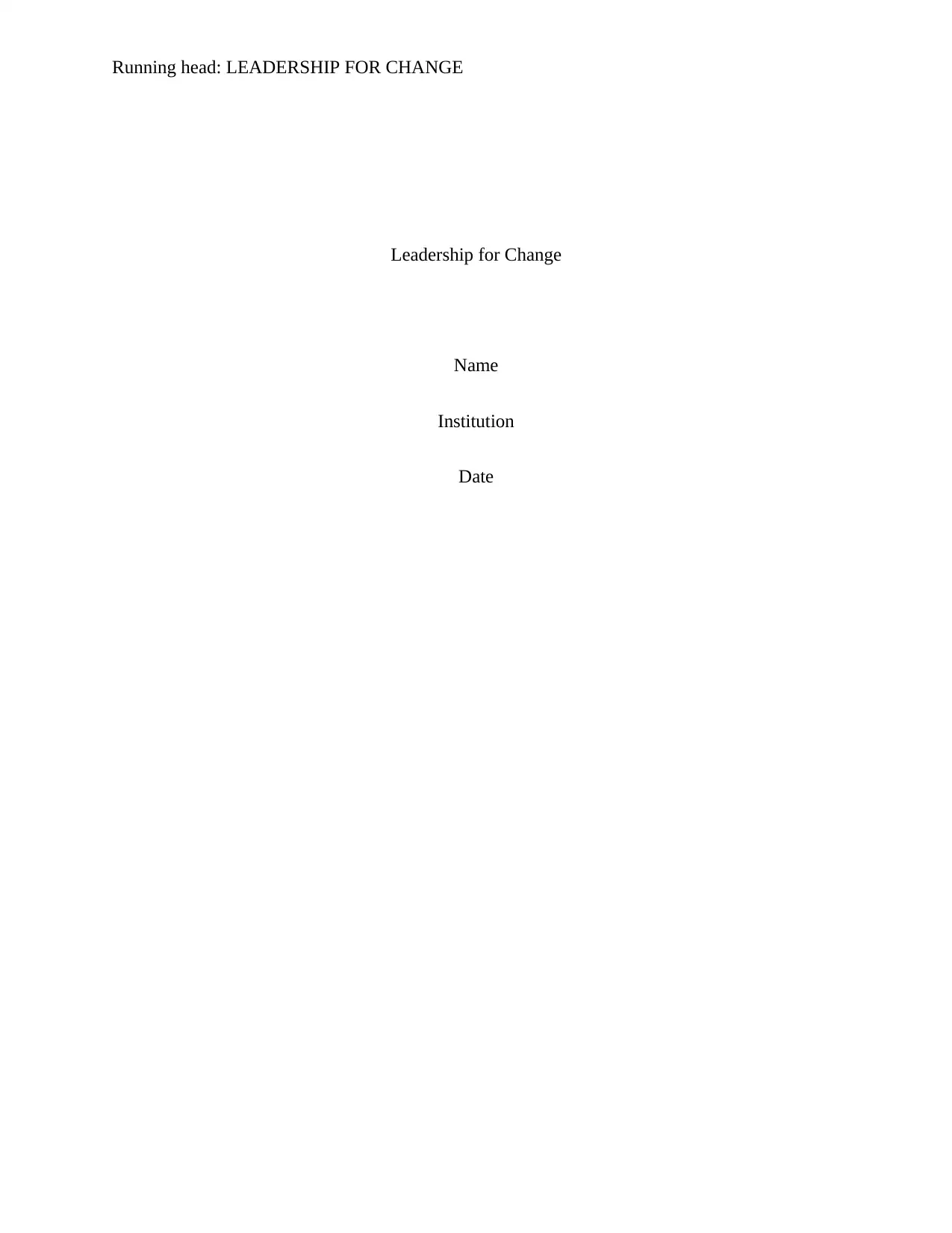
Running head: LEADERSHIP FOR CHANGE
Leadership for Change
Name
Institution
Date
Leadership for Change
Name
Institution
Date
Paraphrase This Document
Need a fresh take? Get an instant paraphrase of this document with our AI Paraphraser
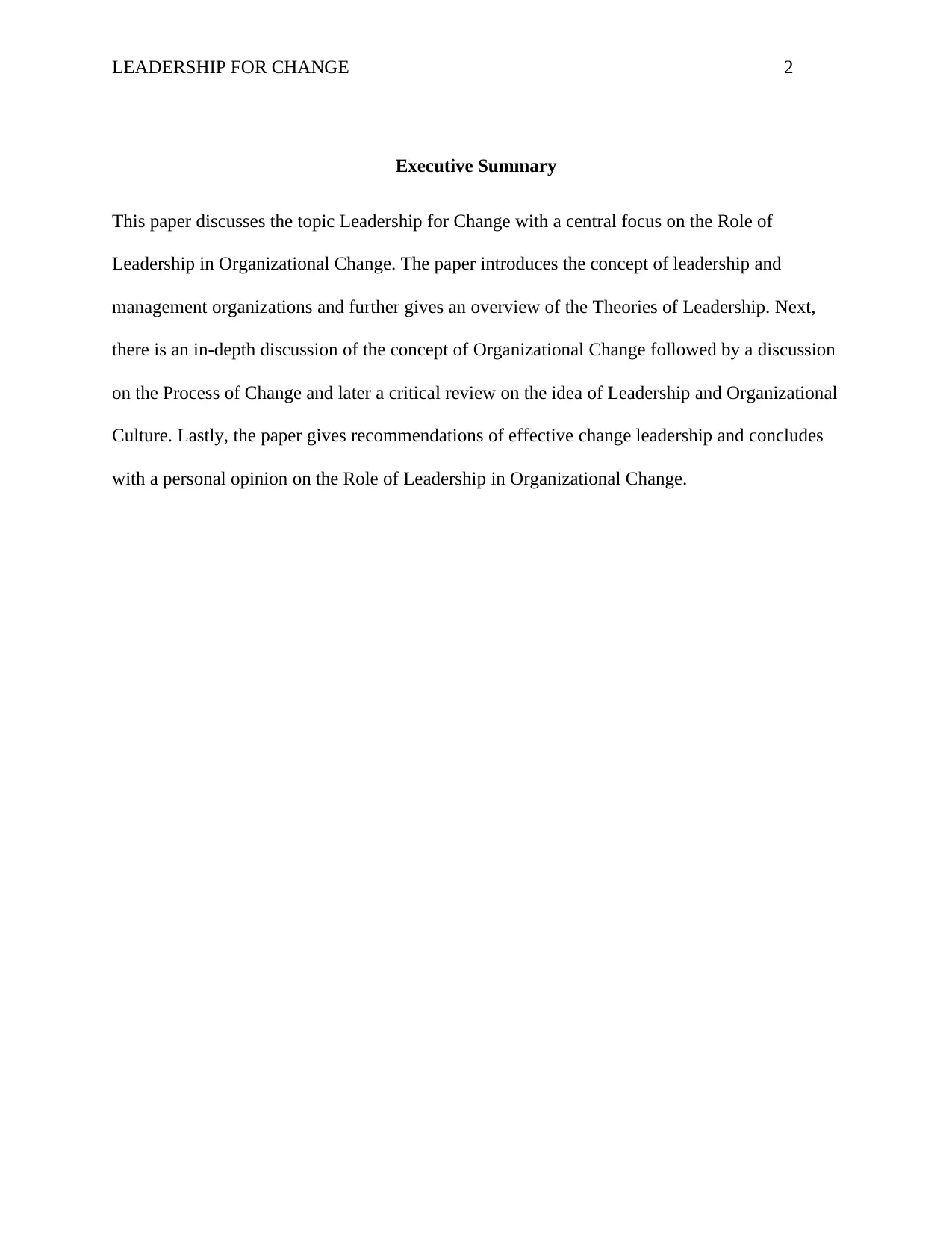
LEADERSHIP FOR CHANGE 2
Executive Summary
This paper discusses the topic Leadership for Change with a central focus on the Role of
Leadership in Organizational Change. The paper introduces the concept of leadership and
management organizations and further gives an overview of the Theories of Leadership. Next,
there is an in-depth discussion of the concept of Organizational Change followed by a discussion
on the Process of Change and later a critical review on the idea of Leadership and Organizational
Culture. Lastly, the paper gives recommendations of effective change leadership and concludes
with a personal opinion on the Role of Leadership in Organizational Change.
Executive Summary
This paper discusses the topic Leadership for Change with a central focus on the Role of
Leadership in Organizational Change. The paper introduces the concept of leadership and
management organizations and further gives an overview of the Theories of Leadership. Next,
there is an in-depth discussion of the concept of Organizational Change followed by a discussion
on the Process of Change and later a critical review on the idea of Leadership and Organizational
Culture. Lastly, the paper gives recommendations of effective change leadership and concludes
with a personal opinion on the Role of Leadership in Organizational Change.
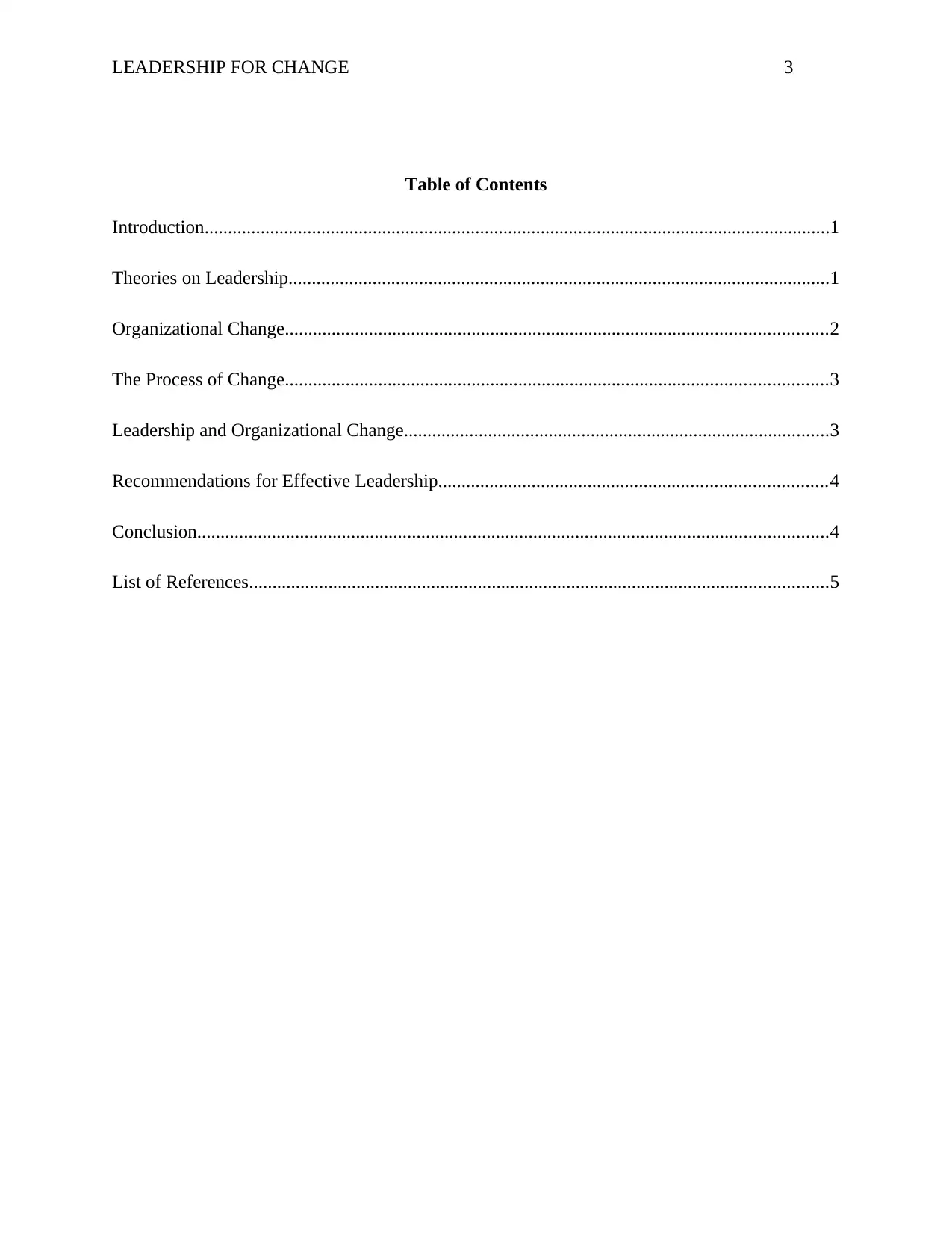
LEADERSHIP FOR CHANGE 3
Table of Contents
Introduction......................................................................................................................................1
Theories on Leadership....................................................................................................................1
Organizational Change....................................................................................................................2
The Process of Change....................................................................................................................3
Leadership and Organizational Change...........................................................................................3
Recommendations for Effective Leadership...................................................................................4
Conclusion.......................................................................................................................................4
List of References............................................................................................................................5
Table of Contents
Introduction......................................................................................................................................1
Theories on Leadership....................................................................................................................1
Organizational Change....................................................................................................................2
The Process of Change....................................................................................................................3
Leadership and Organizational Change...........................................................................................3
Recommendations for Effective Leadership...................................................................................4
Conclusion.......................................................................................................................................4
List of References............................................................................................................................5
⊘ This is a preview!⊘
Do you want full access?
Subscribe today to unlock all pages.

Trusted by 1+ million students worldwide
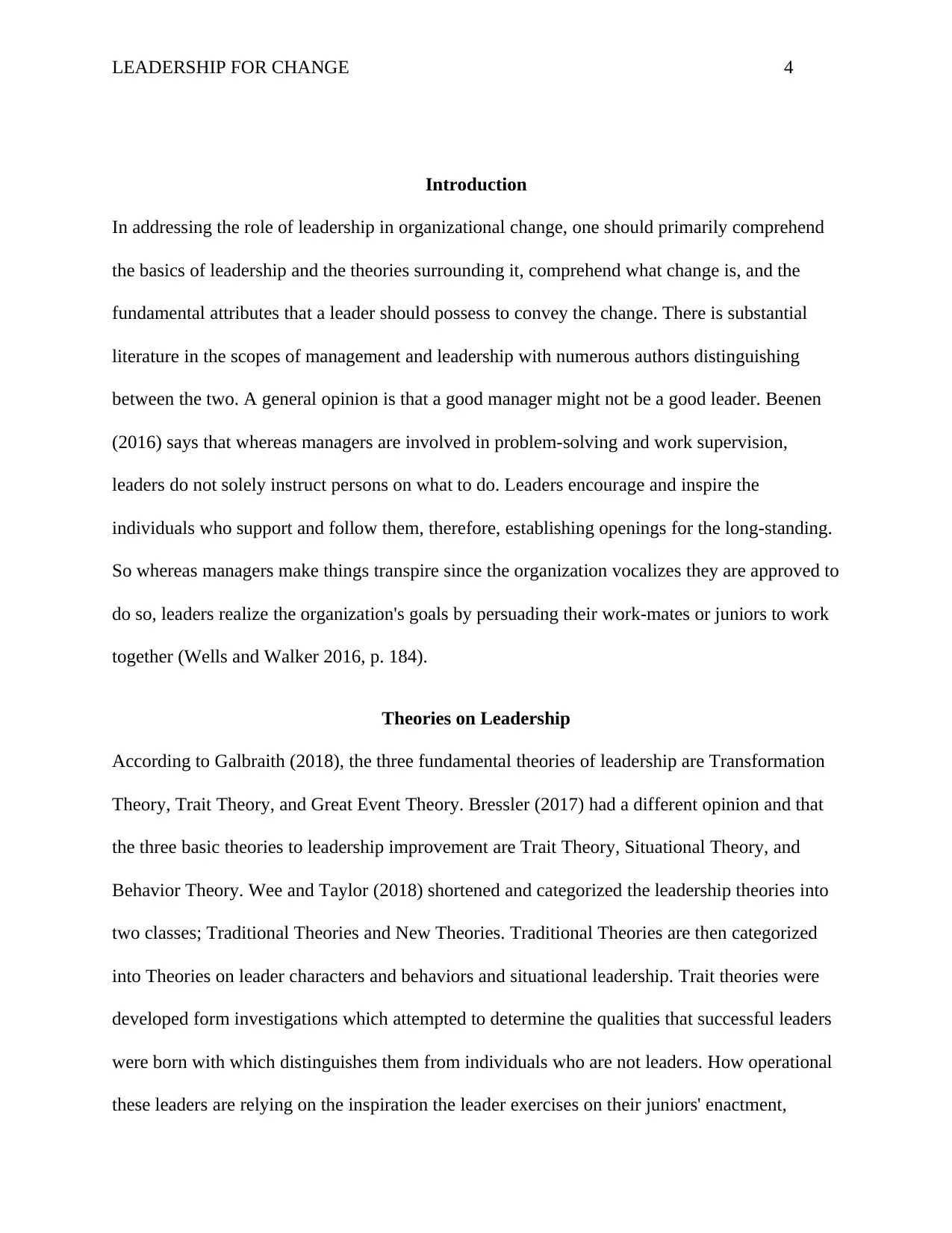
LEADERSHIP FOR CHANGE 4
Introduction
In addressing the role of leadership in organizational change, one should primarily comprehend
the basics of leadership and the theories surrounding it, comprehend what change is, and the
fundamental attributes that a leader should possess to convey the change. There is substantial
literature in the scopes of management and leadership with numerous authors distinguishing
between the two. A general opinion is that a good manager might not be a good leader. Beenen
(2016) says that whereas managers are involved in problem-solving and work supervision,
leaders do not solely instruct persons on what to do. Leaders encourage and inspire the
individuals who support and follow them, therefore, establishing openings for the long-standing.
So whereas managers make things transpire since the organization vocalizes they are approved to
do so, leaders realize the organization's goals by persuading their work-mates or juniors to work
together (Wells and Walker 2016, p. 184).
Theories on Leadership
According to Galbraith (2018), the three fundamental theories of leadership are Transformation
Theory, Trait Theory, and Great Event Theory. Bressler (2017) had a different opinion and that
the three basic theories to leadership improvement are Trait Theory, Situational Theory, and
Behavior Theory. Wee and Taylor (2018) shortened and categorized the leadership theories into
two classes; Traditional Theories and New Theories. Traditional Theories are then categorized
into Theories on leader characters and behaviors and situational leadership. Trait theories were
developed form investigations which attempted to determine the qualities that successful leaders
were born with which distinguishes them from individuals who are not leaders. How operational
these leaders are relying on the inspiration the leader exercises on their juniors' enactment,
Introduction
In addressing the role of leadership in organizational change, one should primarily comprehend
the basics of leadership and the theories surrounding it, comprehend what change is, and the
fundamental attributes that a leader should possess to convey the change. There is substantial
literature in the scopes of management and leadership with numerous authors distinguishing
between the two. A general opinion is that a good manager might not be a good leader. Beenen
(2016) says that whereas managers are involved in problem-solving and work supervision,
leaders do not solely instruct persons on what to do. Leaders encourage and inspire the
individuals who support and follow them, therefore, establishing openings for the long-standing.
So whereas managers make things transpire since the organization vocalizes they are approved to
do so, leaders realize the organization's goals by persuading their work-mates or juniors to work
together (Wells and Walker 2016, p. 184).
Theories on Leadership
According to Galbraith (2018), the three fundamental theories of leadership are Transformation
Theory, Trait Theory, and Great Event Theory. Bressler (2017) had a different opinion and that
the three basic theories to leadership improvement are Trait Theory, Situational Theory, and
Behavior Theory. Wee and Taylor (2018) shortened and categorized the leadership theories into
two classes; Traditional Theories and New Theories. Traditional Theories are then categorized
into Theories on leader characters and behaviors and situational leadership. Trait theories were
developed form investigations which attempted to determine the qualities that successful leaders
were born with which distinguishes them from individuals who are not leaders. How operational
these leaders are relying on the inspiration the leader exercises on their juniors' enactment,
Paraphrase This Document
Need a fresh take? Get an instant paraphrase of this document with our AI Paraphraser
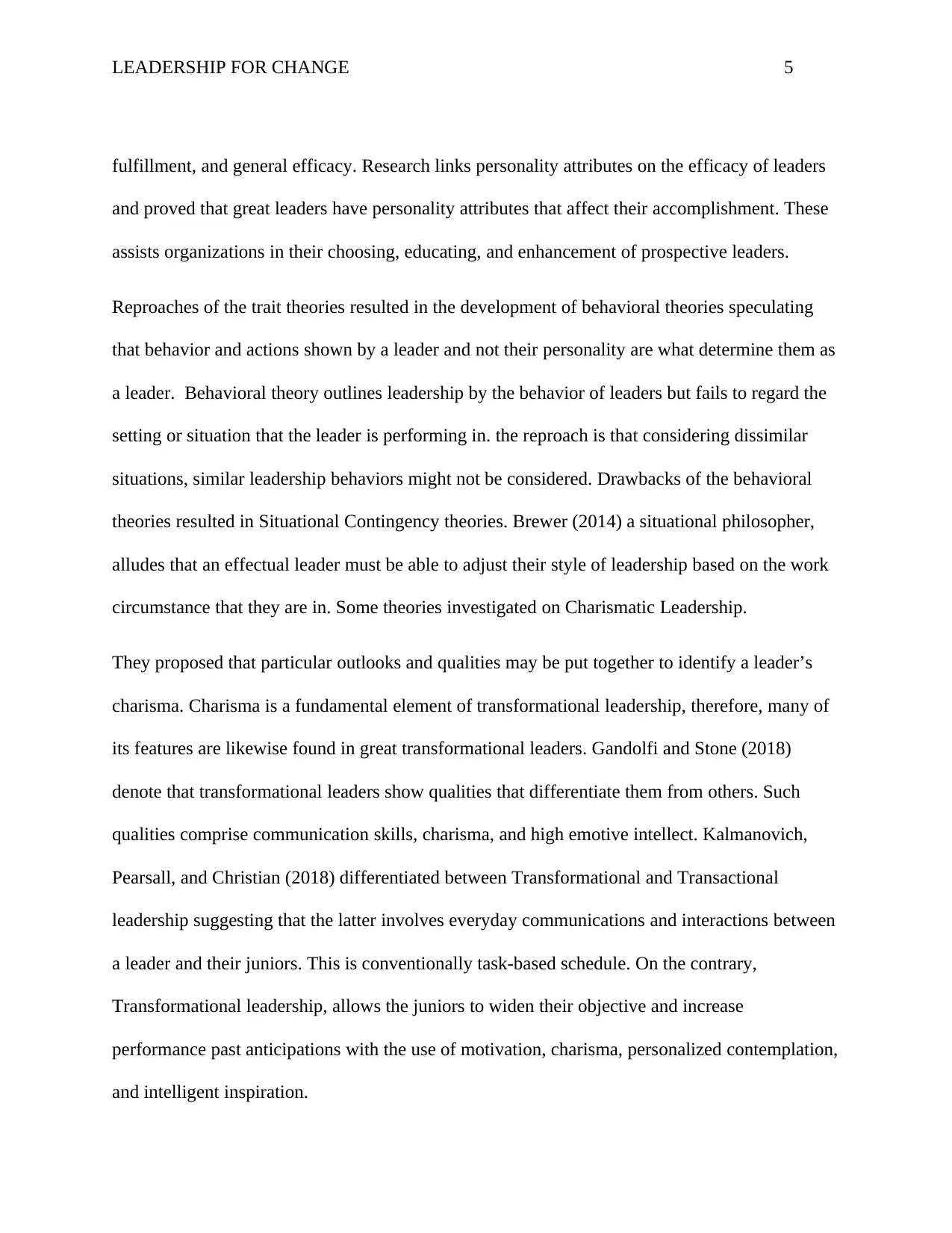
LEADERSHIP FOR CHANGE 5
fulfillment, and general efficacy. Research links personality attributes on the efficacy of leaders
and proved that great leaders have personality attributes that affect their accomplishment. These
assists organizations in their choosing, educating, and enhancement of prospective leaders.
Reproaches of the trait theories resulted in the development of behavioral theories speculating
that behavior and actions shown by a leader and not their personality are what determine them as
a leader. Behavioral theory outlines leadership by the behavior of leaders but fails to regard the
setting or situation that the leader is performing in. the reproach is that considering dissimilar
situations, similar leadership behaviors might not be considered. Drawbacks of the behavioral
theories resulted in Situational Contingency theories. Brewer (2014) a situational philosopher,
alludes that an effectual leader must be able to adjust their style of leadership based on the work
circumstance that they are in. Some theories investigated on Charismatic Leadership.
They proposed that particular outlooks and qualities may be put together to identify a leader’s
charisma. Charisma is a fundamental element of transformational leadership, therefore, many of
its features are likewise found in great transformational leaders. Gandolfi and Stone (2018)
denote that transformational leaders show qualities that differentiate them from others. Such
qualities comprise communication skills, charisma, and high emotive intellect. Kalmanovich,
Pearsall, and Christian (2018) differentiated between Transformational and Transactional
leadership suggesting that the latter involves everyday communications and interactions between
a leader and their juniors. This is conventionally task-based schedule. On the contrary,
Transformational leadership, allows the juniors to widen their objective and increase
performance past anticipations with the use of motivation, charisma, personalized contemplation,
and intelligent inspiration.
fulfillment, and general efficacy. Research links personality attributes on the efficacy of leaders
and proved that great leaders have personality attributes that affect their accomplishment. These
assists organizations in their choosing, educating, and enhancement of prospective leaders.
Reproaches of the trait theories resulted in the development of behavioral theories speculating
that behavior and actions shown by a leader and not their personality are what determine them as
a leader. Behavioral theory outlines leadership by the behavior of leaders but fails to regard the
setting or situation that the leader is performing in. the reproach is that considering dissimilar
situations, similar leadership behaviors might not be considered. Drawbacks of the behavioral
theories resulted in Situational Contingency theories. Brewer (2014) a situational philosopher,
alludes that an effectual leader must be able to adjust their style of leadership based on the work
circumstance that they are in. Some theories investigated on Charismatic Leadership.
They proposed that particular outlooks and qualities may be put together to identify a leader’s
charisma. Charisma is a fundamental element of transformational leadership, therefore, many of
its features are likewise found in great transformational leaders. Gandolfi and Stone (2018)
denote that transformational leaders show qualities that differentiate them from others. Such
qualities comprise communication skills, charisma, and high emotive intellect. Kalmanovich,
Pearsall, and Christian (2018) differentiated between Transformational and Transactional
leadership suggesting that the latter involves everyday communications and interactions between
a leader and their juniors. This is conventionally task-based schedule. On the contrary,
Transformational leadership, allows the juniors to widen their objective and increase
performance past anticipations with the use of motivation, charisma, personalized contemplation,
and intelligent inspiration.
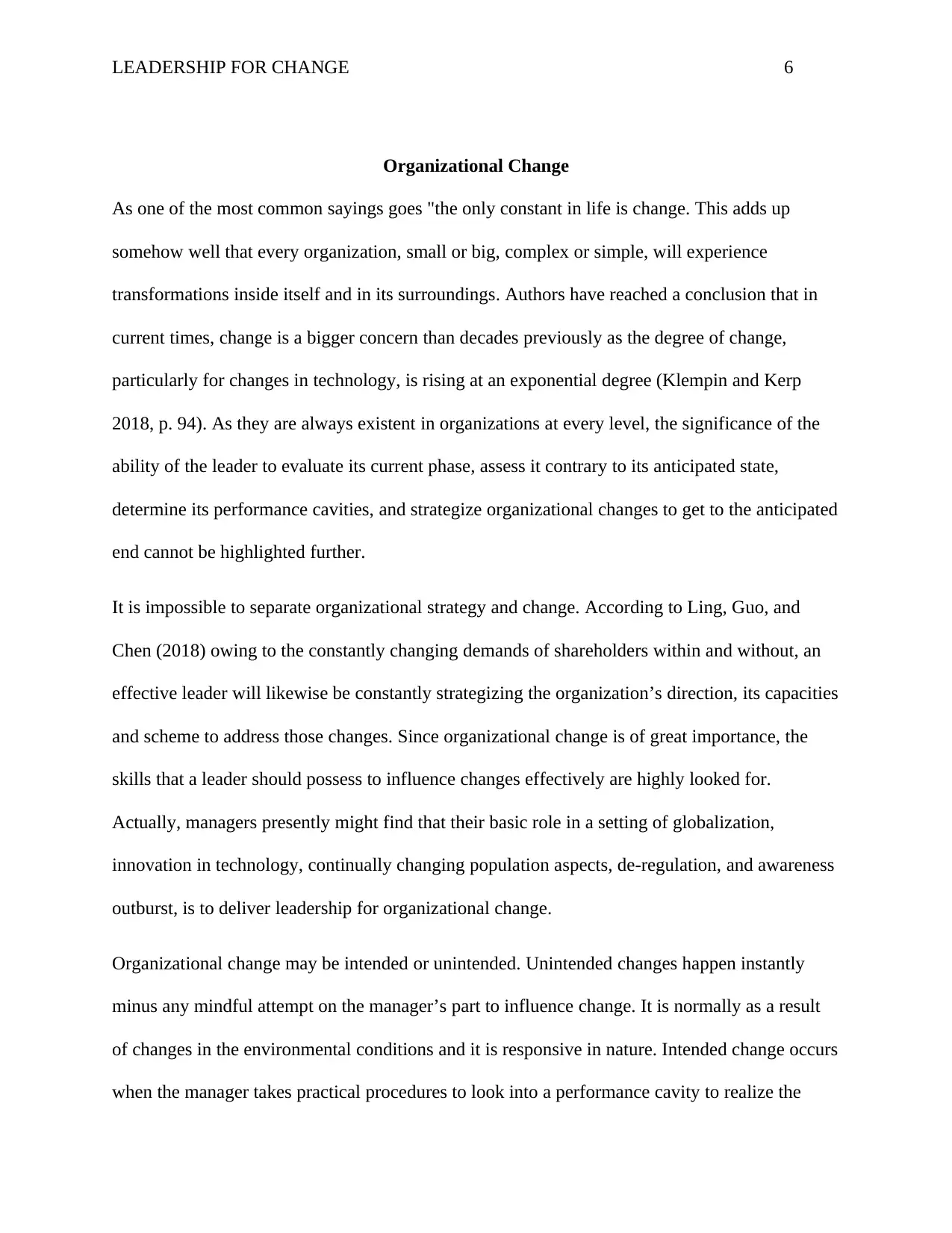
LEADERSHIP FOR CHANGE 6
Organizational Change
As one of the most common sayings goes "the only constant in life is change. This adds up
somehow well that every organization, small or big, complex or simple, will experience
transformations inside itself and in its surroundings. Authors have reached a conclusion that in
current times, change is a bigger concern than decades previously as the degree of change,
particularly for changes in technology, is rising at an exponential degree (Klempin and Kerp
2018, p. 94). As they are always existent in organizations at every level, the significance of the
ability of the leader to evaluate its current phase, assess it contrary to its anticipated state,
determine its performance cavities, and strategize organizational changes to get to the anticipated
end cannot be highlighted further.
It is impossible to separate organizational strategy and change. According to Ling, Guo, and
Chen (2018) owing to the constantly changing demands of shareholders within and without, an
effective leader will likewise be constantly strategizing the organization’s direction, its capacities
and scheme to address those changes. Since organizational change is of great importance, the
skills that a leader should possess to influence changes effectively are highly looked for.
Actually, managers presently might find that their basic role in a setting of globalization,
innovation in technology, continually changing population aspects, de-regulation, and awareness
outburst, is to deliver leadership for organizational change.
Organizational change may be intended or unintended. Unintended changes happen instantly
minus any mindful attempt on the manager’s part to influence change. It is normally as a result
of changes in the environmental conditions and it is responsive in nature. Intended change occurs
when the manager takes practical procedures to look into a performance cavity to realize the
Organizational Change
As one of the most common sayings goes "the only constant in life is change. This adds up
somehow well that every organization, small or big, complex or simple, will experience
transformations inside itself and in its surroundings. Authors have reached a conclusion that in
current times, change is a bigger concern than decades previously as the degree of change,
particularly for changes in technology, is rising at an exponential degree (Klempin and Kerp
2018, p. 94). As they are always existent in organizations at every level, the significance of the
ability of the leader to evaluate its current phase, assess it contrary to its anticipated state,
determine its performance cavities, and strategize organizational changes to get to the anticipated
end cannot be highlighted further.
It is impossible to separate organizational strategy and change. According to Ling, Guo, and
Chen (2018) owing to the constantly changing demands of shareholders within and without, an
effective leader will likewise be constantly strategizing the organization’s direction, its capacities
and scheme to address those changes. Since organizational change is of great importance, the
skills that a leader should possess to influence changes effectively are highly looked for.
Actually, managers presently might find that their basic role in a setting of globalization,
innovation in technology, continually changing population aspects, de-regulation, and awareness
outburst, is to deliver leadership for organizational change.
Organizational change may be intended or unintended. Unintended changes happen instantly
minus any mindful attempt on the manager’s part to influence change. It is normally as a result
of changes in the environmental conditions and it is responsive in nature. Intended change occurs
when the manager takes practical procedures to look into a performance cavity to realize the
⊘ This is a preview!⊘
Do you want full access?
Subscribe today to unlock all pages.

Trusted by 1+ million students worldwide
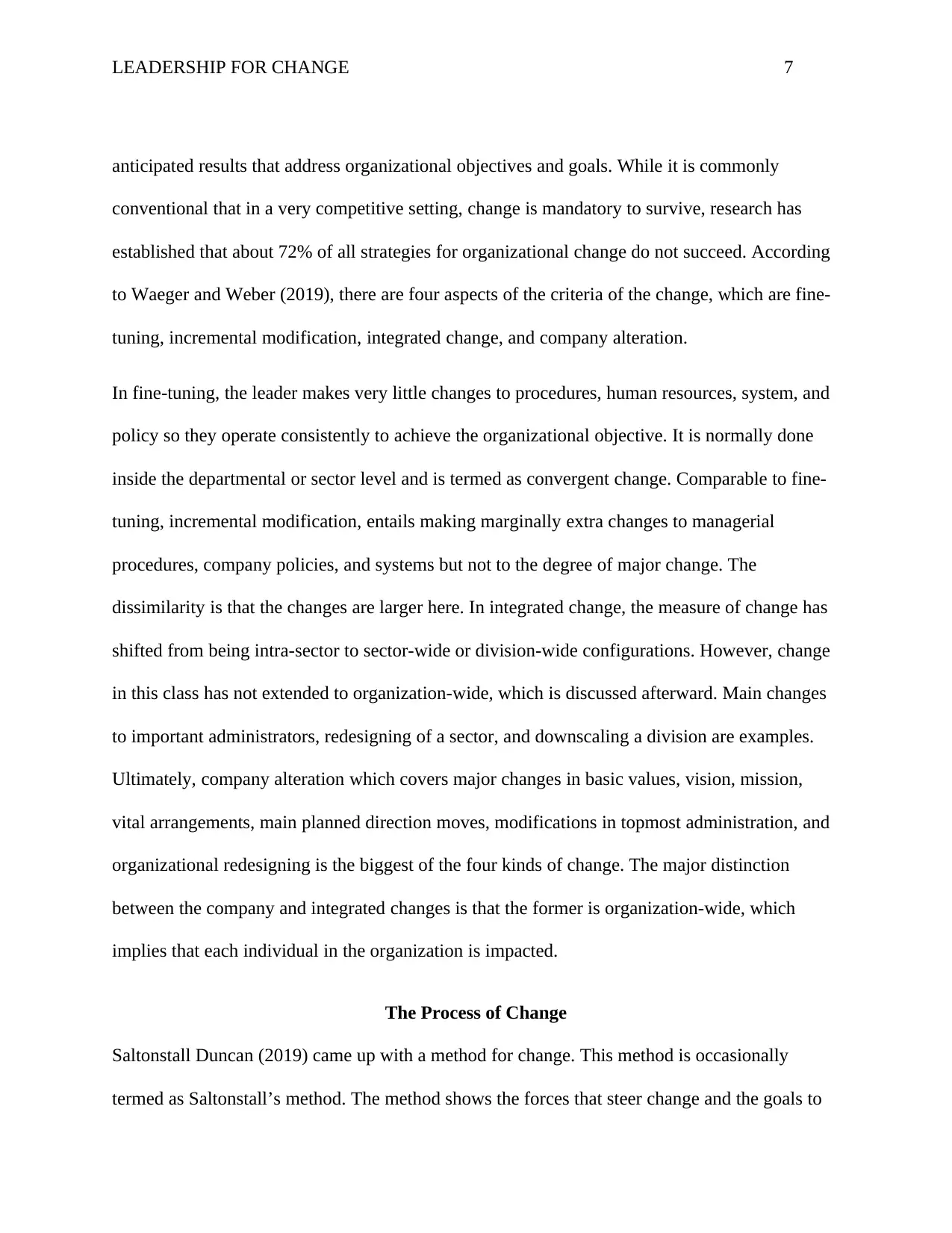
LEADERSHIP FOR CHANGE 7
anticipated results that address organizational objectives and goals. While it is commonly
conventional that in a very competitive setting, change is mandatory to survive, research has
established that about 72% of all strategies for organizational change do not succeed. According
to Waeger and Weber (2019), there are four aspects of the criteria of the change, which are fine-
tuning, incremental modification, integrated change, and company alteration.
In fine-tuning, the leader makes very little changes to procedures, human resources, system, and
policy so they operate consistently to achieve the organizational objective. It is normally done
inside the departmental or sector level and is termed as convergent change. Comparable to fine-
tuning, incremental modification, entails making marginally extra changes to managerial
procedures, company policies, and systems but not to the degree of major change. The
dissimilarity is that the changes are larger here. In integrated change, the measure of change has
shifted from being intra-sector to sector-wide or division-wide configurations. However, change
in this class has not extended to organization-wide, which is discussed afterward. Main changes
to important administrators, redesigning of a sector, and downscaling a division are examples.
Ultimately, company alteration which covers major changes in basic values, vision, mission,
vital arrangements, main planned direction moves, modifications in topmost administration, and
organizational redesigning is the biggest of the four kinds of change. The major distinction
between the company and integrated changes is that the former is organization-wide, which
implies that each individual in the organization is impacted.
The Process of Change
Saltonstall Duncan (2019) came up with a method for change. This method is occasionally
termed as Saltonstall’s method. The method shows the forces that steer change and the goals to
anticipated results that address organizational objectives and goals. While it is commonly
conventional that in a very competitive setting, change is mandatory to survive, research has
established that about 72% of all strategies for organizational change do not succeed. According
to Waeger and Weber (2019), there are four aspects of the criteria of the change, which are fine-
tuning, incremental modification, integrated change, and company alteration.
In fine-tuning, the leader makes very little changes to procedures, human resources, system, and
policy so they operate consistently to achieve the organizational objective. It is normally done
inside the departmental or sector level and is termed as convergent change. Comparable to fine-
tuning, incremental modification, entails making marginally extra changes to managerial
procedures, company policies, and systems but not to the degree of major change. The
dissimilarity is that the changes are larger here. In integrated change, the measure of change has
shifted from being intra-sector to sector-wide or division-wide configurations. However, change
in this class has not extended to organization-wide, which is discussed afterward. Main changes
to important administrators, redesigning of a sector, and downscaling a division are examples.
Ultimately, company alteration which covers major changes in basic values, vision, mission,
vital arrangements, main planned direction moves, modifications in topmost administration, and
organizational redesigning is the biggest of the four kinds of change. The major distinction
between the company and integrated changes is that the former is organization-wide, which
implies that each individual in the organization is impacted.
The Process of Change
Saltonstall Duncan (2019) came up with a method for change. This method is occasionally
termed as Saltonstall’s method. The method shows the forces that steer change and the goals to
Paraphrase This Document
Need a fresh take? Get an instant paraphrase of this document with our AI Paraphraser
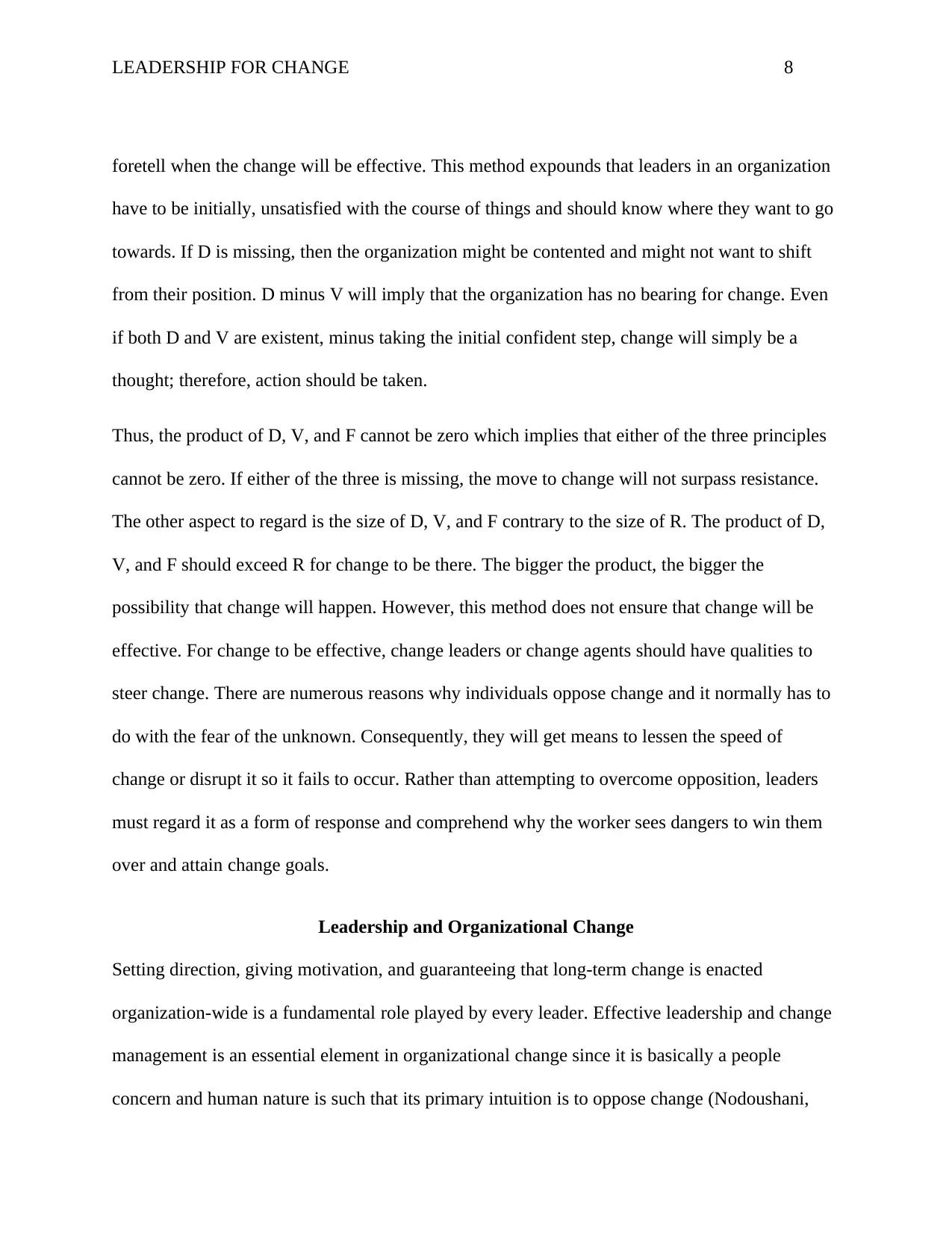
LEADERSHIP FOR CHANGE 8
foretell when the change will be effective. This method expounds that leaders in an organization
have to be initially, unsatisfied with the course of things and should know where they want to go
towards. If D is missing, then the organization might be contented and might not want to shift
from their position. D minus V will imply that the organization has no bearing for change. Even
if both D and V are existent, minus taking the initial confident step, change will simply be a
thought; therefore, action should be taken.
Thus, the product of D, V, and F cannot be zero which implies that either of the three principles
cannot be zero. If either of the three is missing, the move to change will not surpass resistance.
The other aspect to regard is the size of D, V, and F contrary to the size of R. The product of D,
V, and F should exceed R for change to be there. The bigger the product, the bigger the
possibility that change will happen. However, this method does not ensure that change will be
effective. For change to be effective, change leaders or change agents should have qualities to
steer change. There are numerous reasons why individuals oppose change and it normally has to
do with the fear of the unknown. Consequently, they will get means to lessen the speed of
change or disrupt it so it fails to occur. Rather than attempting to overcome opposition, leaders
must regard it as a form of response and comprehend why the worker sees dangers to win them
over and attain change goals.
Leadership and Organizational Change
Setting direction, giving motivation, and guaranteeing that long-term change is enacted
organization-wide is a fundamental role played by every leader. Effective leadership and change
management is an essential element in organizational change since it is basically a people
concern and human nature is such that its primary intuition is to oppose change (Nodoushani,
foretell when the change will be effective. This method expounds that leaders in an organization
have to be initially, unsatisfied with the course of things and should know where they want to go
towards. If D is missing, then the organization might be contented and might not want to shift
from their position. D minus V will imply that the organization has no bearing for change. Even
if both D and V are existent, minus taking the initial confident step, change will simply be a
thought; therefore, action should be taken.
Thus, the product of D, V, and F cannot be zero which implies that either of the three principles
cannot be zero. If either of the three is missing, the move to change will not surpass resistance.
The other aspect to regard is the size of D, V, and F contrary to the size of R. The product of D,
V, and F should exceed R for change to be there. The bigger the product, the bigger the
possibility that change will happen. However, this method does not ensure that change will be
effective. For change to be effective, change leaders or change agents should have qualities to
steer change. There are numerous reasons why individuals oppose change and it normally has to
do with the fear of the unknown. Consequently, they will get means to lessen the speed of
change or disrupt it so it fails to occur. Rather than attempting to overcome opposition, leaders
must regard it as a form of response and comprehend why the worker sees dangers to win them
over and attain change goals.
Leadership and Organizational Change
Setting direction, giving motivation, and guaranteeing that long-term change is enacted
organization-wide is a fundamental role played by every leader. Effective leadership and change
management is an essential element in organizational change since it is basically a people
concern and human nature is such that its primary intuition is to oppose change (Nodoushani,
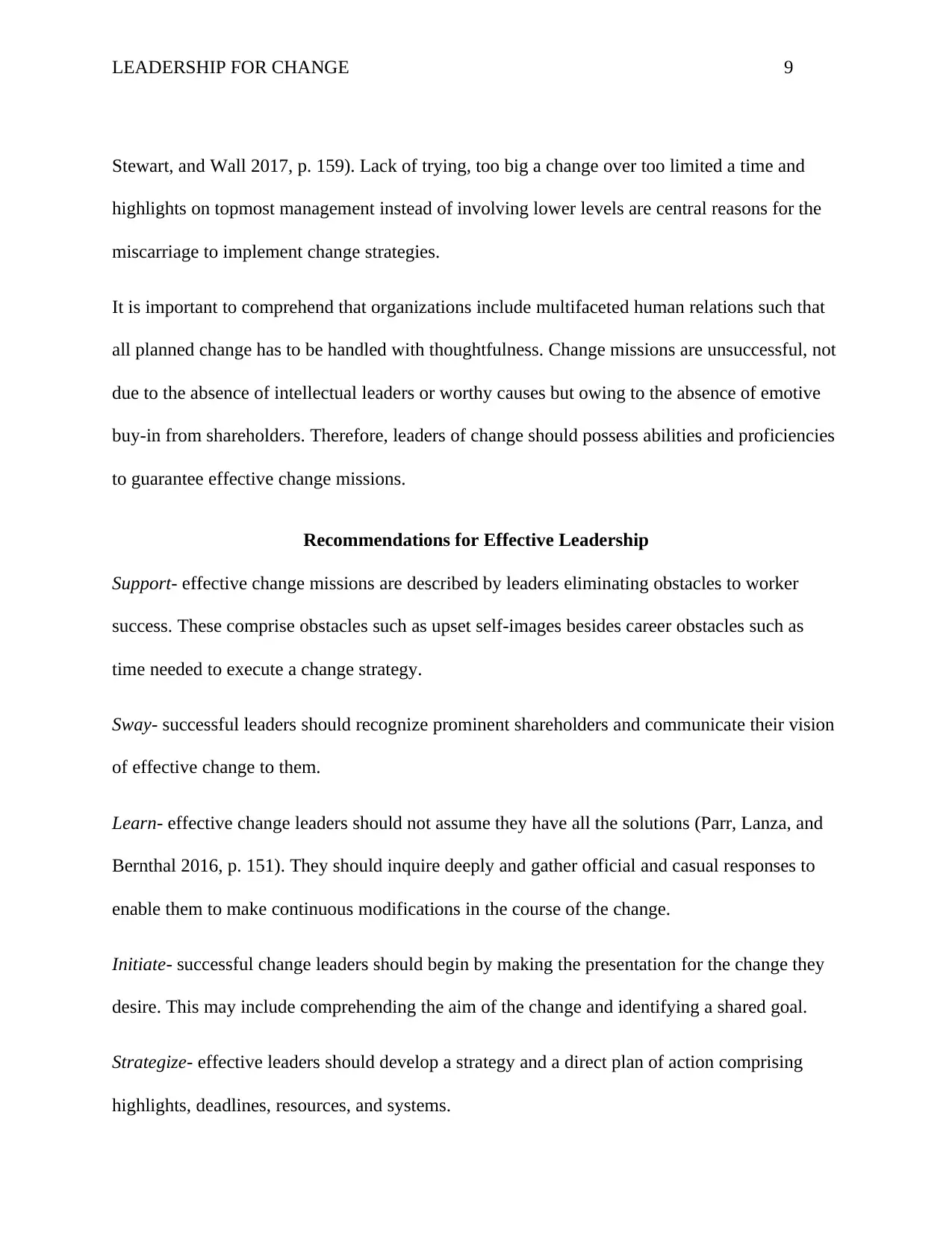
LEADERSHIP FOR CHANGE 9
Stewart, and Wall 2017, p. 159). Lack of trying, too big a change over too limited a time and
highlights on topmost management instead of involving lower levels are central reasons for the
miscarriage to implement change strategies.
It is important to comprehend that organizations include multifaceted human relations such that
all planned change has to be handled with thoughtfulness. Change missions are unsuccessful, not
due to the absence of intellectual leaders or worthy causes but owing to the absence of emotive
buy-in from shareholders. Therefore, leaders of change should possess abilities and proficiencies
to guarantee effective change missions.
Recommendations for Effective Leadership
Support- effective change missions are described by leaders eliminating obstacles to worker
success. These comprise obstacles such as upset self-images besides career obstacles such as
time needed to execute a change strategy.
Sway- successful leaders should recognize prominent shareholders and communicate their vision
of effective change to them.
Learn- effective change leaders should not assume they have all the solutions (Parr, Lanza, and
Bernthal 2016, p. 151). They should inquire deeply and gather official and casual responses to
enable them to make continuous modifications in the course of the change.
Initiate- successful change leaders should begin by making the presentation for the change they
desire. This may include comprehending the aim of the change and identifying a shared goal.
Strategize- effective leaders should develop a strategy and a direct plan of action comprising
highlights, deadlines, resources, and systems.
Stewart, and Wall 2017, p. 159). Lack of trying, too big a change over too limited a time and
highlights on topmost management instead of involving lower levels are central reasons for the
miscarriage to implement change strategies.
It is important to comprehend that organizations include multifaceted human relations such that
all planned change has to be handled with thoughtfulness. Change missions are unsuccessful, not
due to the absence of intellectual leaders or worthy causes but owing to the absence of emotive
buy-in from shareholders. Therefore, leaders of change should possess abilities and proficiencies
to guarantee effective change missions.
Recommendations for Effective Leadership
Support- effective change missions are described by leaders eliminating obstacles to worker
success. These comprise obstacles such as upset self-images besides career obstacles such as
time needed to execute a change strategy.
Sway- successful leaders should recognize prominent shareholders and communicate their vision
of effective change to them.
Learn- effective change leaders should not assume they have all the solutions (Parr, Lanza, and
Bernthal 2016, p. 151). They should inquire deeply and gather official and casual responses to
enable them to make continuous modifications in the course of the change.
Initiate- successful change leaders should begin by making the presentation for the change they
desire. This may include comprehending the aim of the change and identifying a shared goal.
Strategize- effective leaders should develop a strategy and a direct plan of action comprising
highlights, deadlines, resources, and systems.
⊘ This is a preview!⊘
Do you want full access?
Subscribe today to unlock all pages.

Trusted by 1+ million students worldwide
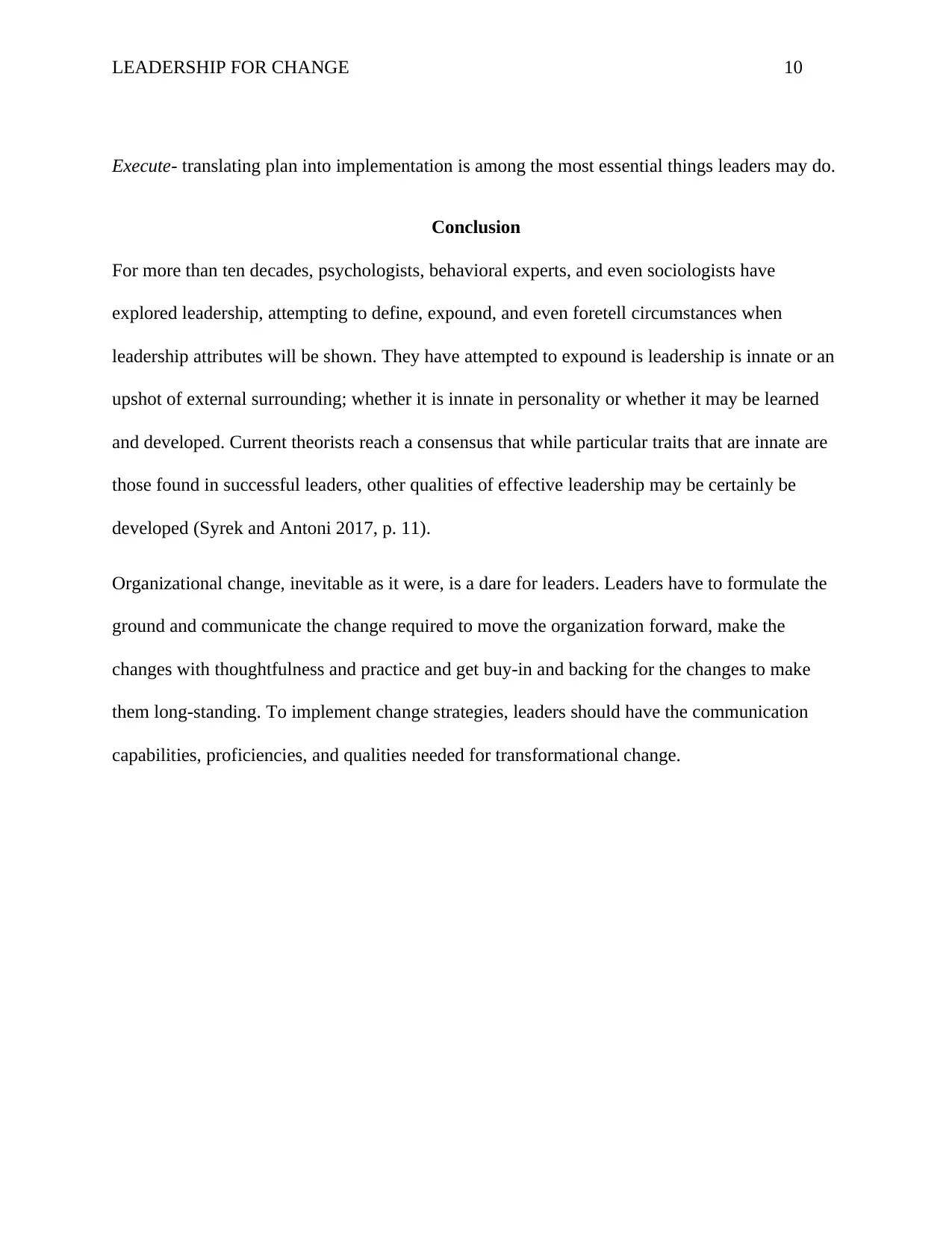
LEADERSHIP FOR CHANGE 10
Execute- translating plan into implementation is among the most essential things leaders may do.
Conclusion
For more than ten decades, psychologists, behavioral experts, and even sociologists have
explored leadership, attempting to define, expound, and even foretell circumstances when
leadership attributes will be shown. They have attempted to expound is leadership is innate or an
upshot of external surrounding; whether it is innate in personality or whether it may be learned
and developed. Current theorists reach a consensus that while particular traits that are innate are
those found in successful leaders, other qualities of effective leadership may be certainly be
developed (Syrek and Antoni 2017, p. 11).
Organizational change, inevitable as it were, is a dare for leaders. Leaders have to formulate the
ground and communicate the change required to move the organization forward, make the
changes with thoughtfulness and practice and get buy-in and backing for the changes to make
them long-standing. To implement change strategies, leaders should have the communication
capabilities, proficiencies, and qualities needed for transformational change.
Execute- translating plan into implementation is among the most essential things leaders may do.
Conclusion
For more than ten decades, psychologists, behavioral experts, and even sociologists have
explored leadership, attempting to define, expound, and even foretell circumstances when
leadership attributes will be shown. They have attempted to expound is leadership is innate or an
upshot of external surrounding; whether it is innate in personality or whether it may be learned
and developed. Current theorists reach a consensus that while particular traits that are innate are
those found in successful leaders, other qualities of effective leadership may be certainly be
developed (Syrek and Antoni 2017, p. 11).
Organizational change, inevitable as it were, is a dare for leaders. Leaders have to formulate the
ground and communicate the change required to move the organization forward, make the
changes with thoughtfulness and practice and get buy-in and backing for the changes to make
them long-standing. To implement change strategies, leaders should have the communication
capabilities, proficiencies, and qualities needed for transformational change.
Paraphrase This Document
Need a fresh take? Get an instant paraphrase of this document with our AI Paraphraser
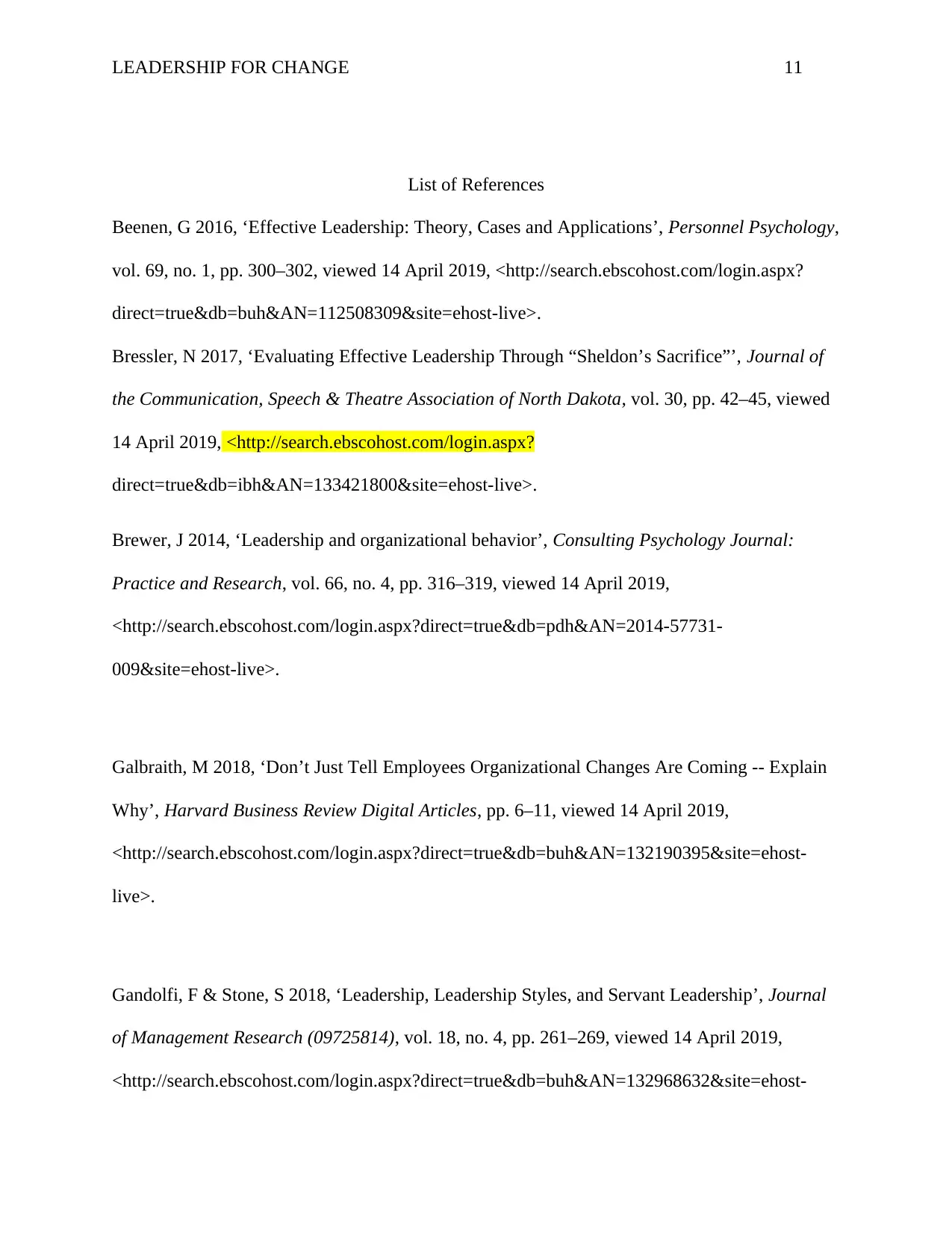
LEADERSHIP FOR CHANGE 11
List of References
Beenen, G 2016, ‘Effective Leadership: Theory, Cases and Applications’, Personnel Psychology,
vol. 69, no. 1, pp. 300–302, viewed 14 April 2019, <http://search.ebscohost.com/login.aspx?
direct=true&db=buh&AN=112508309&site=ehost-live>.
Bressler, N 2017, ‘Evaluating Effective Leadership Through “Sheldon’s Sacrifice”’, Journal of
the Communication, Speech & Theatre Association of North Dakota, vol. 30, pp. 42–45, viewed
14 April 2019, <http://search.ebscohost.com/login.aspx?
direct=true&db=ibh&AN=133421800&site=ehost-live>.
Brewer, J 2014, ‘Leadership and organizational behavior’, Consulting Psychology Journal:
Practice and Research, vol. 66, no. 4, pp. 316–319, viewed 14 April 2019,
<http://search.ebscohost.com/login.aspx?direct=true&db=pdh&AN=2014-57731-
009&site=ehost-live>.
Galbraith, M 2018, ‘Don’t Just Tell Employees Organizational Changes Are Coming -- Explain
Why’, Harvard Business Review Digital Articles, pp. 6–11, viewed 14 April 2019,
<http://search.ebscohost.com/login.aspx?direct=true&db=buh&AN=132190395&site=ehost-
live>.
Gandolfi, F & Stone, S 2018, ‘Leadership, Leadership Styles, and Servant Leadership’, Journal
of Management Research (09725814), vol. 18, no. 4, pp. 261–269, viewed 14 April 2019,
<http://search.ebscohost.com/login.aspx?direct=true&db=buh&AN=132968632&site=ehost-
List of References
Beenen, G 2016, ‘Effective Leadership: Theory, Cases and Applications’, Personnel Psychology,
vol. 69, no. 1, pp. 300–302, viewed 14 April 2019, <http://search.ebscohost.com/login.aspx?
direct=true&db=buh&AN=112508309&site=ehost-live>.
Bressler, N 2017, ‘Evaluating Effective Leadership Through “Sheldon’s Sacrifice”’, Journal of
the Communication, Speech & Theatre Association of North Dakota, vol. 30, pp. 42–45, viewed
14 April 2019, <http://search.ebscohost.com/login.aspx?
direct=true&db=ibh&AN=133421800&site=ehost-live>.
Brewer, J 2014, ‘Leadership and organizational behavior’, Consulting Psychology Journal:
Practice and Research, vol. 66, no. 4, pp. 316–319, viewed 14 April 2019,
<http://search.ebscohost.com/login.aspx?direct=true&db=pdh&AN=2014-57731-
009&site=ehost-live>.
Galbraith, M 2018, ‘Don’t Just Tell Employees Organizational Changes Are Coming -- Explain
Why’, Harvard Business Review Digital Articles, pp. 6–11, viewed 14 April 2019,
<http://search.ebscohost.com/login.aspx?direct=true&db=buh&AN=132190395&site=ehost-
live>.
Gandolfi, F & Stone, S 2018, ‘Leadership, Leadership Styles, and Servant Leadership’, Journal
of Management Research (09725814), vol. 18, no. 4, pp. 261–269, viewed 14 April 2019,
<http://search.ebscohost.com/login.aspx?direct=true&db=buh&AN=132968632&site=ehost-
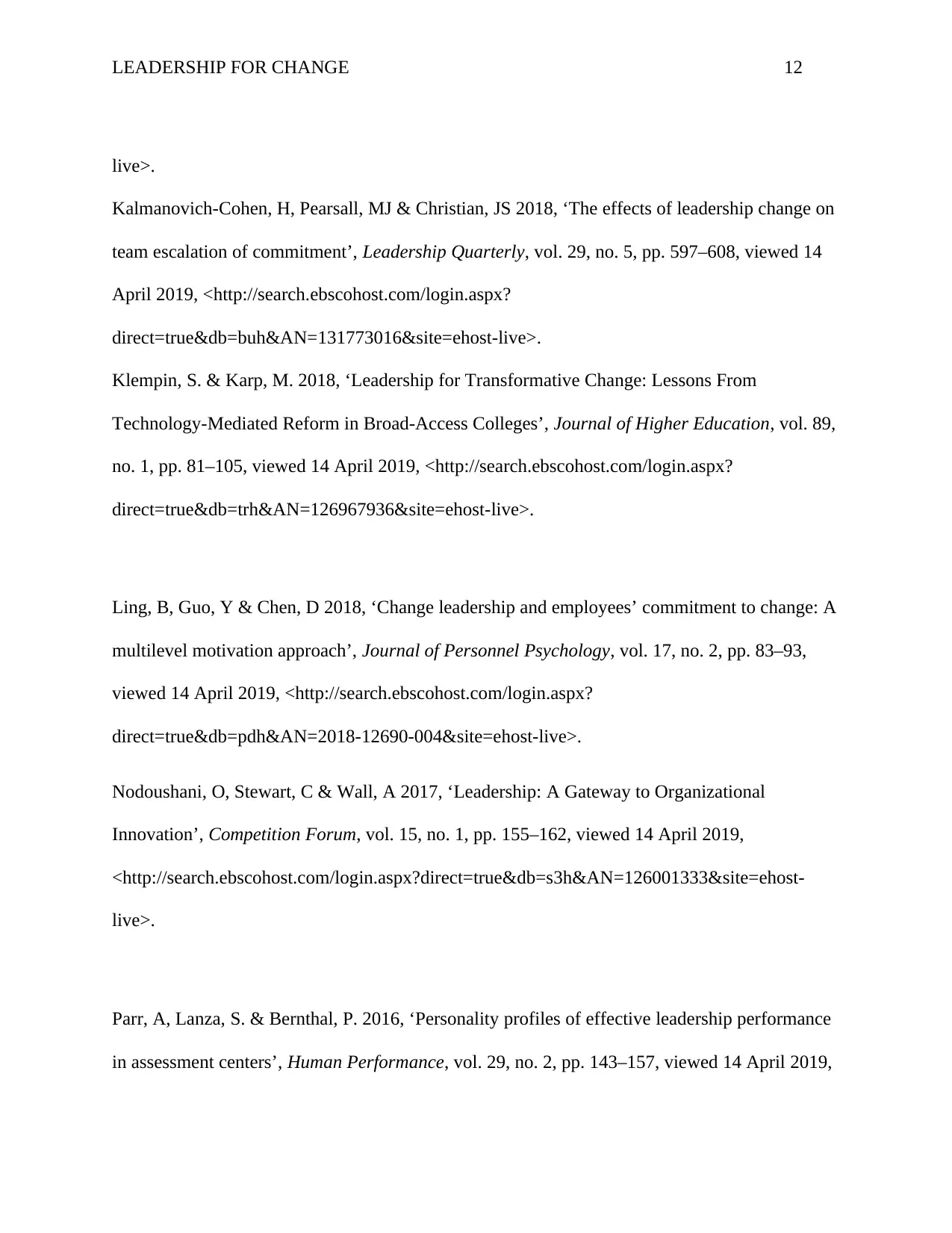
LEADERSHIP FOR CHANGE 12
live>.
Kalmanovich-Cohen, H, Pearsall, MJ & Christian, JS 2018, ‘The effects of leadership change on
team escalation of commitment’, Leadership Quarterly, vol. 29, no. 5, pp. 597–608, viewed 14
April 2019, <http://search.ebscohost.com/login.aspx?
direct=true&db=buh&AN=131773016&site=ehost-live>.
Klempin, S. & Karp, M. 2018, ‘Leadership for Transformative Change: Lessons From
Technology-Mediated Reform in Broad-Access Colleges’, Journal of Higher Education, vol. 89,
no. 1, pp. 81–105, viewed 14 April 2019, <http://search.ebscohost.com/login.aspx?
direct=true&db=trh&AN=126967936&site=ehost-live>.
Ling, B, Guo, Y & Chen, D 2018, ‘Change leadership and employees’ commitment to change: A
multilevel motivation approach’, Journal of Personnel Psychology, vol. 17, no. 2, pp. 83–93,
viewed 14 April 2019, <http://search.ebscohost.com/login.aspx?
direct=true&db=pdh&AN=2018-12690-004&site=ehost-live>.
Nodoushani, O, Stewart, C & Wall, A 2017, ‘Leadership: A Gateway to Organizational
Innovation’, Competition Forum, vol. 15, no. 1, pp. 155–162, viewed 14 April 2019,
<http://search.ebscohost.com/login.aspx?direct=true&db=s3h&AN=126001333&site=ehost-
live>.
Parr, A, Lanza, S. & Bernthal, P. 2016, ‘Personality profiles of effective leadership performance
in assessment centers’, Human Performance, vol. 29, no. 2, pp. 143–157, viewed 14 April 2019,
live>.
Kalmanovich-Cohen, H, Pearsall, MJ & Christian, JS 2018, ‘The effects of leadership change on
team escalation of commitment’, Leadership Quarterly, vol. 29, no. 5, pp. 597–608, viewed 14
April 2019, <http://search.ebscohost.com/login.aspx?
direct=true&db=buh&AN=131773016&site=ehost-live>.
Klempin, S. & Karp, M. 2018, ‘Leadership for Transformative Change: Lessons From
Technology-Mediated Reform in Broad-Access Colleges’, Journal of Higher Education, vol. 89,
no. 1, pp. 81–105, viewed 14 April 2019, <http://search.ebscohost.com/login.aspx?
direct=true&db=trh&AN=126967936&site=ehost-live>.
Ling, B, Guo, Y & Chen, D 2018, ‘Change leadership and employees’ commitment to change: A
multilevel motivation approach’, Journal of Personnel Psychology, vol. 17, no. 2, pp. 83–93,
viewed 14 April 2019, <http://search.ebscohost.com/login.aspx?
direct=true&db=pdh&AN=2018-12690-004&site=ehost-live>.
Nodoushani, O, Stewart, C & Wall, A 2017, ‘Leadership: A Gateway to Organizational
Innovation’, Competition Forum, vol. 15, no. 1, pp. 155–162, viewed 14 April 2019,
<http://search.ebscohost.com/login.aspx?direct=true&db=s3h&AN=126001333&site=ehost-
live>.
Parr, A, Lanza, S. & Bernthal, P. 2016, ‘Personality profiles of effective leadership performance
in assessment centers’, Human Performance, vol. 29, no. 2, pp. 143–157, viewed 14 April 2019,
⊘ This is a preview!⊘
Do you want full access?
Subscribe today to unlock all pages.

Trusted by 1+ million students worldwide
1 out of 14
Related Documents
Your All-in-One AI-Powered Toolkit for Academic Success.
+13062052269
info@desklib.com
Available 24*7 on WhatsApp / Email
![[object Object]](/_next/static/media/star-bottom.7253800d.svg)
Unlock your academic potential
Copyright © 2020–2025 A2Z Services. All Rights Reserved. Developed and managed by ZUCOL.





